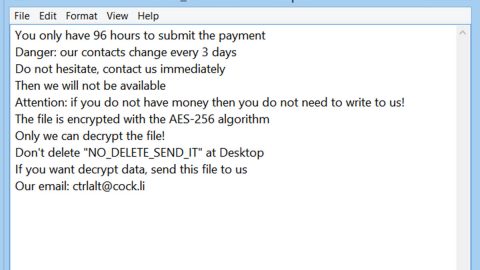What is PGPSnippet ([email protected]) ([email protected]) ransomware? And how does it implement its attack?
PGPSnippet ([email protected]) ([email protected]) ransomware is a new and improved version of PGPSnippet ([email protected]) ransomware. Previously, it uses the [email protected] extension in marking encrypted files but it now uses the [email protected] extension in marking the files it encrypts. Like the previous version, the new PGPSnippet ([email protected]) ([email protected]) ransomware is designed to encrypt files in an infected system and leave them inaccessible to victims.
According to security experts, nothing much has changed in this new version except its new ability to self-delete its own files after it has implemented its attack so it will most likely leave behind only a handful of malicious components. This kind of ability allows it to infect all newly created files that match the targeted files which are as follows:
.txt, .doc, .docx, .xls, .index, .pdf, .zip, .rar, .css, .lnk, .xlsx, .ppt, .pptx, .odt, .jpg, .bmp, .png, .csv, .sql, .mdb, .sln, .php, .asp, .aspx, .html, .xml, .psd, .bk, .bat, .mp3, .mp4, .wav, .wma, .avi, .divx, .mkv, .mpeg, .wmv, .mov, .ogg, .java, .csv, .kdc, .dxg, .xlsm, .pps, .cpp, .odt, .php, .odc, .log, .exe, .cr2, .mpeg, .jpeg, .xqx, .dotx, .pps, .class, .jar, .psd, .pot, .cmd, .rtf, .csv, .php, .docm, .xlsm, .js, .wsf, .vbs, .ini, .jpeg, .gif, .7z, .dotx, .kdc, .odm, .xll, .xlt, .ps, .mpeg, .pem, .msg, .xls, .wav, .odp, .nef, .pmd, .r3d, .dll, .reg, .hwp, .7z, .p12, .pfx, .cs, .ico, .torrent, .c
The execution of the malicious files of PGPSnippet ([email protected]) ransomware is possible by exploiting some specific registry keys’ functionalities. This allows the ransomware to run on every system boot, hence, making its presence in the system persistent.
PGPSnippet ([email protected]) ransomware uses a strong encryption algorithm in marking its targeted files. Once it achieves the encryption of these files, it will drop a file named “!!!README_DECRYPT!!!.txt” which contains the following text:
“ATTENTION!
All your documents and other files ENCRYPTED !!!
TO RESTORE YOUR FILES YOU MUST PAY: 1 by Bitcoin to this address: 11zc6pm11fQiWXDAG7urFTeBUu9UGe***
You can open a wallet here:
https://electrum.org/#download
https://blockchain.info
https://localbitcoins.com/
https://paxful.com/en
https://www.bestchanee.com/
Send the file on the way “WIN + R >> %APPDATA%” file name hosts.txt to our e-mail after payment at this email address: [email protected]
We will confirm payment and send to you decrypt key + instruction
Remember: you have 72 hours and if you not paid, that price will up
ATTENTION: all your attempts to decrypt your PC without our software and key can lead to irreversible destruction
of your files !”
As you should know, paying the ransom demanded by the crooks behind this threat does not really guarantee the recovery of your files so it’s best if you don’t contact them. The best way to deal with this kind of threat is to obliterate it from your system the moment you notice its presence before it can damage more important data.
How does PGPSnippet ([email protected]) ([email protected]) ransomware proliferate?
Just like the previous version, creators of PGPSnippet ([email protected]) ransomware utilize spam emails to proliferate this threat. These emails contain a corrupted attachment that once opened, will launch the file-encrypting virus into the system. This is why you have to double check every email you receive especially those suspicious ones as crooks tend to disguise these emails and put some catchy subjects in them just to grab your attention.
To obliterate PGPSnippet ([email protected]) ransomware from your computer, you need to follow the set of instructions laid out below.
Step 1: Launch the Task Manager by simply tapping Ctrl + Shift + Esc keys on your keyboard.
Step 2: Under the Task Manager, go to the Processes tab and look for any suspicious-looking process which takes up most of your CPU’s resources and is most likely related to PGPSnippet ([email protected]) ransomware.

Step 3: After that, close the Task Manager.
Step 4: Tap Win + R, type in appwiz.cpl and click OK or tap Enter to open Control Panel’s list of installed programs.
Step 5: Under the list of installed programs, look for PGPSnippet ([email protected]) ransomware or anything similar and then uninstall it.

Step 6: Next, close Control Panel and tap Win + E keys to launch File Explorer.
Step 7: Navigate to the following locations below and look for PGPSnippet ([email protected]) ransomware’s malicious components such as “[random name].exe” and “README_DECRYPT!!!.txt” and other suspicious files, then delete all of them.
- %TEMP%
- %WINDIR%\System32\Tasks
- %APPDATA%\Microsoft\Windows\Templates\
- %USERPROFILE%\Downloads
- %USERPROFILE%\Desktop
Step 8: Close the File Explorer.
Before you proceed to the next steps below, make sure that you are tech savvy enough to the point where you know exactly how to use and navigate your computer’s Registry. Keep in mind that any changes you make will highly impact your computer. To save you the trouble and time, you can just use [product-name], this system tool is proven to be safe and excellent enough that hackers won’t be able to hack into it. But if you can manage Windows Registry well, then, by all means, go on to the next steps.
Step 9: Tap Win + R to open Run and then type in regedit in the field and tap enter to pull up Windows Registry.

Step 10: Navigate to the following path:
- HKEY_CURRENT_USER\Control Panel\Desktop\
- HKEY_USERS\.DEFAULT\Control Panel\Desktop\
- HKEY_LOCAL_MACHINE\Software\Microsoft\Windows\CurrentVersion\Run
- HKEY_CURRENT_USER\Software\Microsoft\Windows\CurrentVersion\Run
- HKEY_LOCAL_MACHINE\Software\Microsoft\Windows\CurrentVersion\RunOnce
- HKEY_CURRENT_USER\Software\Microsoft\Windows\CurrentVersion\RunOnce
Step 11: Delete the registry keys and sub-keys created by PGPSnippet ([email protected]) ransomware.
Step 12: Close the Registry Editor and empty the Recycle Bin.
Try to recover your encrypted files using the Volume Shadow copies
Restoring your encrypted files using Windows’ Previous Versions feature will only be effective if PGPSnippet ([email protected]) ransomware hasn’t deleted the shadow copies of your files. But still, this is one of the best and free methods there is, so it’s definitely worth a shot.
To restore the encrypted file, right-click on it and select Properties, a new window will pop-up, then proceed to Previous Versions. It will load the file’s previous version before it was modified. After it loads, select any of the previous versions displayed on the list like the one in the illustration below. And then click the Restore button.

Complete the removal process of PGPSnippet ([email protected]) ransomware by using a trusted and reliable program like [product-name]. Refer to the following guidelines on how to use it.
Perform a full system scan using [product-code]. To do so, follow these steps:
- Turn on your computer. If it’s already on, you have to reboot
- After that, the BIOS screen will be displayed, but if Windows pops up instead, reboot your computer and try again. Once you’re on the BIOS screen, repeat pressing F8, by doing so the Advanced Option shows up.
- To navigate the Advanced Option use the arrow keys and select Safe Mode with Networking then hit
- Windows will now load the SafeMode with Networking.
- Press and hold both R key and Windows key.
- If done correctly, the Windows Run Box will show up.
- Type in the URL address, [product-url] in the Run dialog box and then tap Enter or click OK.
- After that, it will download the program. Wait for the download to finish and then open the launcher to install the program.
- Once the installation process is completed, run [product-code] to perform a full system scan.
















